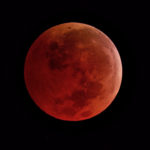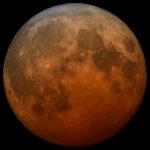NASAの公式サイトでスーパームーンについて説明をしているページ「スーパームーンとは何か?(What is a Supermoon?)」が2021年5月20日に更新されました。
このページは、2016年のスーパームーンの観測データをベースにしたもので、スーパームーンについて「何が特別なのか(So what’s so special about a supermoon?)」解説しています。
NASAは、スーパームーンは1979年に作られた新しい呼称で、月が満月になると同時に、月の軌道が地球に最も近い(近地点)時にある月のことだと伝えています。
NASAの公式サイトのURLはこちら:
What is a Supermoon? – NASA Solar System Exploration
以下はオリジナル原文と和訳です。
What is a Supermoon?
Fast Facts
A supermoon occurs when the Moon’s orbit is closest (perigee) to Earth at the same time the Moon is full. So what’s so special about a supermoon? For the interested observer, there’s plenty to see and learn.
- The Moon orbits Earth in an ellipse, an oval that brings it closer to and farther from Earth as it goes around.
- The farthest point in this ellipse is called the apogee and is about 253,000 miles (405,500 kilometers) from Earth on average.
- Its closest point is the perigee, which is an average distance of about 226,000 miles (363,300 kilometers) from Earth.
- When a full moon appears at perigee it is slightly brighter and larger than a regular full moon – and that’s where we get a “supermoon.
スーパームーンは、月が満月になると同時に、月の軌道が地球に最も近い(近地点)時に発生します。で、スーパームーンの何がそんなに特別なのか?スーパームーンに関心を持つ人には、それを見たり学んだりすることがたくさんあります。
- 月は楕円軌道で地球を周回しますので、月が周回するときに地球に近づいたり遠ざかったします。
- この楕円の最も遠い点は遠地点と呼ばれ、平均して地球から約253,000マイル(405,500キロメートル)です。
- 最も近い地点は近地点であり、地球からの平均距離は約226,000マイル(363,300キロメートル)です。
- 満月が近地点に現れるとき、それは通常の満月よりわずかに明るく大きくなります - それが「スーパームーン」なのです。
In Depth
The term “supermoon” was coined in 1979 and is often used to describe what astronomers would call a perigean (pear-ih-jee-un) full moon: a full moon occurring near or at the time when the Moon is at the closest point in its orbit around Earth.
The term gives preference to the geometric alignment of Sun-Earth-Moon and allows the occurrence of perigee into a wider time period than the actual instant of perigee (up to about two weeks, which is almost half of the Moon’s orbit).
For those looking carefully, there are several things worth noting. Take a look at the lunar images from November 2016 below:
「スーパームーン」という用語は1979年に造られ、天文学者が近地点潮(pear-ih-jee-un)満月と呼ぶものを説明する際によく使われます:満月は月が地球の周りの軌道で最も近い地点や付近で発生します。
この用語は、太陽-地球-月の幾何学的配置が優先され、正確な近地点よりも広い期間(最大約2週間、月の軌道のほぼ半分)で近地点が発生することを含んでいます。
注意深く見ている人にとって、注目に値するいくつかのことがあります。以下の2016年11月の月の画像をご覧ください。

The figure’s left image was taken after moonrise, at about 6 p.m. local time when it had cleared the local, mountainous horizon. The right image was taken with the Moon near its maximum altitude that night, at about 12:30 a.m. The lines across the pair of images show the apparent difference in size: The rising moon is smaller because it was further away when it was rising. At that time, the Moon’s center was about the same distance from Earth’s center and from the observer. At the time of the second picture, Earth had rotated about a quarter-turn and the Moon was highest in the sky. At that time it was almost 4,000 miles closer to the observer because Earth’s rotation has carried the observer more directly under the Moon; Earth’s center was now farther from the Moon than the observer was. Except for the small change in distance between their centers due to the Moon’s orbital motion in those 6.5 hours, the observer’s decrease in distance from the Moon is demonstrated by the pair of photographs.
図の左の画像は、月の出後の現地時間で午後6時頃に撮影されたものです。実際の山の影などは削除してあります。右の画像は、月がその夜の最大高度に近い午前12時30分頃に撮影されたものです。画像にある水平の2本の線は、サイズの明らかな違いを示しています。月が昇るときは遠くにあるため、昇る月は小さくなります。当時、月の中心は地球の中心と観測者からほぼ同じ距離でした。 2枚目の写真の時点で、地球は約4分の1回転しており、月は空で最も高い位置にありました。当時、地球の自転によって観測者が月の真下になったため、観測者は約4,000マイル近づいたことになります。地球の中心は、観測者よりも月から遠くなりました。この6.5時間の月の軌道による中心間の距離のわずかな変化を除いて、観測者の月からの距離の減少が、2枚の写真によって示されているのです。
So, what makes a supermoon different?
Some lunar perigees are closer than others. The shape of the Moon’s orbit changes over time (thanks to the gravitational influence of the Sun and the other planets). Extreme perigees and apogees, or the most distant point in the orbit, happen on a predictable basis. Something that’s out of the ordinary: Having a full moon at the same time as an extreme perigee.
An extreme perigean full moon’s angular radius and diameter will appear slightly larger than it does at other full moons. Let’s go back to November 13-14, 2016, when the extreme perigean full moon’s radius and diameter were:
- Less than 2% larger than an average perigean full moon.
- Less than 8% larger than the full moon’s appearance at its average distance from Earth.
- Less than 14% larger than the average apogean full moon. For comparison, the width of the fingernail on your smallest finger (your “pinkie”), when held at arm’s length, is about the same diameter as the full moon in the sky.
あるケースで月の近地点は他のケースよりも近くなります。月の軌道の形は時間とともに変化します(太陽や他の惑星の重力の影響による)。最も近い近地点、または軌道上で最も遠い遠地点は予測可能です。極端な状態となるのは:極端な近地点と同時に満月となる場合です。
最も近い近地点の満月の角半径と直径は、他の満月よりもわずかに大きくなります。 2016年11月13日から14日、満月の半径と直径が次のようになっていた時のことを考えてみましょう。
- 平均的な近地点満月より2%未満大きい。
- 地球からの平均距離での満月より8%未満大きい。
- 平均的な遠地点満月より14%未満大きい。腕をまっすぐ空に伸ばし比較してみると、最っとも小さな指(「小指」)の爪の幅と、空の満月の直径がほぼ同じになります。
Could you measure any of these differences by eye?
Seen from Earth, the area of sky covered by the extreme perigean November 2016 full moon is greater in area by:
- Less than 4% compared to the average perigean full moon.
- About 14% compared to its appearance at its average distance from Earth.
- Less than 23% larger than the average apogean full moon.
地球から見ると、2016年11月の夜空にあった近地点満月の面積は、次のように大きくなっていました。
- 平均的な近地点満月と比較して4%未満大きい。
- 地球からの平均距離での満月と比較して約14%大きい。
- 平均的な遠地点満月より23%未満大きい。
Setting the Sun’s illumination of the lunar surface during the extreme perigean full moon in November 2016 to a value of 1.00000, the illumination of the Moon at:
- An average perigean full moon is 0.99996.
- An average distance of the full moon is 0.99981.
- An average apogean full moon is 0.99967.
2016年11月の極大の満月の間の月面の太陽の照明、つまり月の明るさを1.00000の値に設定すると、月の明るさは次のようになります。
- 平均的な近地点満月は0.99996です。
- 満月の平均距離は0.99981です。
- 平均的な遠地点満月は0.99967です。
These differences are thanks to the small differences in the Moon’s distance from the Sun. To our own eyes, the differences are indistinguishable.
Illumination of Earth’s surface by the November 2016 extreme perigean full moon was just slightly higher because the Moon was slightly closer to the Sun than usual, and because it appeared slightly larger in the sky than usual compared to other full moons. If the extreme perigean full moon provides an illumination value of 1.00000 on Earth’s surface, the illumination by…
- The average perigean full moon is 0.99991.
- The average distance full moon is 0.99963.
- The average apogean full moon is 0.99934.
これらの違いは、月の太陽からの距離のわずかな違いによるものです。私たち自身の目には、違いは区別できません。
2016年11月の極大の近地点満月による地球の表面の明るさは、月が通常よりもわずかに太陽に近く、他の満月と比較して通常よりも空でわずかに大きく見えたため、わずかに高くなりました。極大の近地点満月が地球の表面に1.00000の照明値を提供する場合では、次のようになります…
- 平均的な近地点満月は0.99991です。
- 満月の平均距離は0.99963です。
- 平均的な遠地点満月は0.99934です。
Looking around you when the full moon is high in the sky and there are no other lights around, the differences in ground illumination are indistinguishable to our eyes.
High tides and low tides will be more extreme with a perigean full moon and more so for an extreme perigean full moon. The extremes are greater due to the difference in the gravitational pull of the Moon across Earth’s diameter. When the Moon is close, Earth’s diameter is a slightly larger fraction of the Earth-Moon separation. This means that the Moon’s gravitational pull on the oceans (and Earth’s crust) has a greater difference between the point on Earth closest to the Moon’s center and the point on Earth diametrically opposite it (the antipode, an-tih-pode). This increases the effects of tides. If the extreme perigean full moon in November 2016 caused tides with a force value of 1.000000, the tidal force value by caused by…
- The average perigean full moon is 0.946493.
- The average distance full moon is 0.797740.
- The average apogean full moon is 0.678594.
Perigean high tides during a full moon and new moon can cause major problems on some coasts, especially if weather adds high waves or a storm surge (due to low atmospheric pressure over the involved area).
満月が空高く、周りに他の照明がない状態で、あなたの周りを見ても、地表の明るさの違いは私たちの目には区別できません。
潮と干潮は、近地点満月ではより大きくなり、極大の近地点満月ではさらに極端になります。地球の直径全体での月の引力の違いにより、潮と干潮はさらに大きくなります。月が近いとき、地球の直径は月の方向にわずかに大きくなります。月が及ぼす海(および地球の地殻)への引力が、月の中心に最も近い地球上の点と、それと正反対の地球上の点(対蹠地)との差が大きいことを意味します。これは潮の影響を増やします。 2016年11月の極度の周縁の満月が1.000000の力の値で潮汐を引き起こした場合、潮汐力の値は…
- 平均的な近地点満月は0.946493です。
- 満月の平均距離は0.797740です。
- 平均的な遠地点満月は0.678594です。
近地点満月と新月の間における満潮は、特に高波または高潮を引き起こすような天候(関係する地域の低気圧のため)であれば、いくつかの海岸で大きな災害を引き起こす可能性があります。
Page Updated: May 20, 2021











